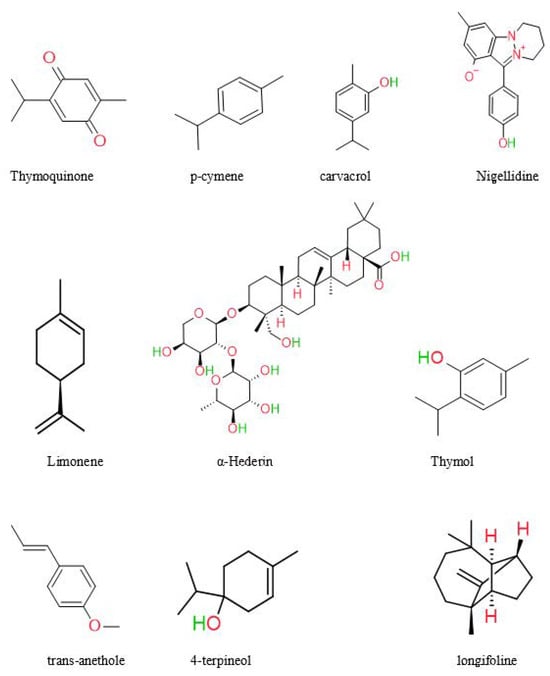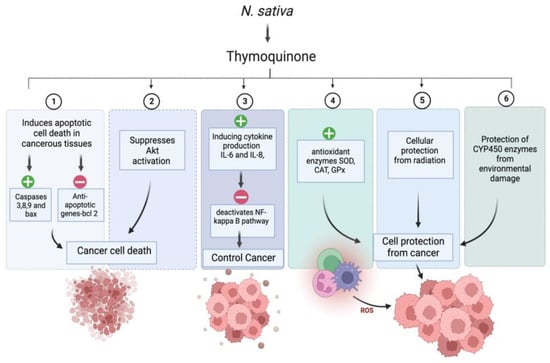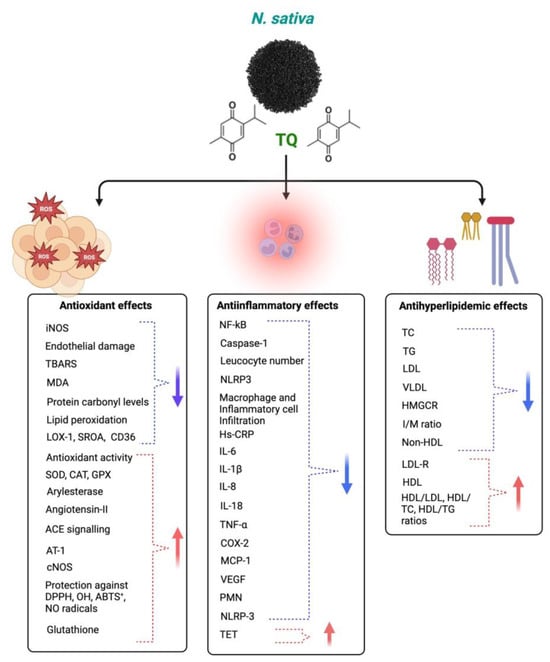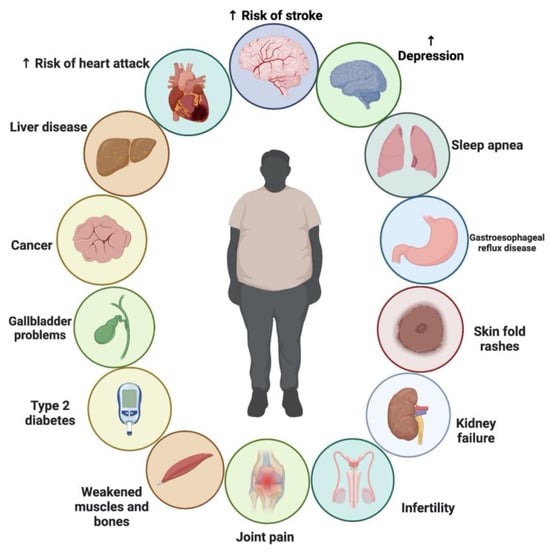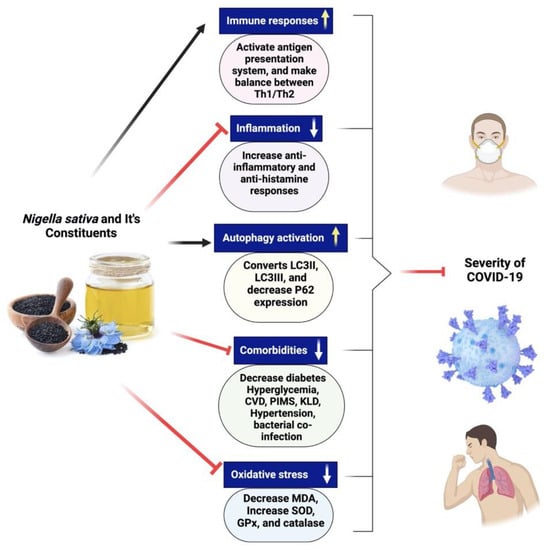1. Introduction
People have used this plant for over a thousand years as a medicine. Evidence of the oldest cultivation of NS has been discovered by archaeologists, with dating indicating its presence as early as the 2nd century BCE [1][11]. Nigella is derived from the Latin word Niger, which means “black”. The word “nigellus” denotes a shade of black or dark, explicitly referring to the color of the seed coat. The cultivation of black cumin is seen in several regions throughout Asia, Africa, Europe, and the Americas. NS is growing wild in Turkey, Iraq, Iran, Syria, and Africa [2][12]. The species is also grown commercially in India [3][13] and other parts of Southern Asia, Pakistan [4][14], Iran [5][15], Western Asia [6][16], Iraq [6][16], Israel [7][17], Jordan [8][18], Syria [9][19], Lebanon [10][20], Turkey [11][21], Yemen [11][21], Sudan [12][22], Northern Africa [12][22], Egypt [6][16], Tunisia [6][16], Ethiopia and Eastern Africa [13][23]. The primary nations engaged in the production of the commodity are India, Bangladesh, Sri Lanka, Pakistan, Afghanistan, Iraq, Iran, Syria, Ethiopia, and Turkey. Black cumin’s natural average productivity has been reported to be 0.79 tons/ha. In 2018, the black cumin oil market was valued at over 15 million USD; substantial growth is anticipated by 2025 [14][24]. India cultivates this plant on a large scale due to its heavy consumption in medicine. Annual quantities of black cumin are estimated to be traded in India for more than 100 metric tons. According to Gashaw’s (2020) findings, the average yield in Ethiopia was recorded at 0.64 tons per hectare, a significantly lower figure compared to other nations known for their high agricultural productivity [13][23]. In 2015, Ermias et al. said the low production was because the cultivars were not very productive [15][25]. In 2008, Hammo said that it was because the farmers were not using good agronomic practices [16][26].
In recent years, significant advancements have been achieved in phytochemistry, and health supplements have gained prominence. The medicinal plant is called a chemical manufacturing industry, since it produces a variety of bioactive molecules such as alkaloids, saponins, oleoresins, resins, glycosides, sesquiterpene lactones, and oils
[17][55]. NS’s most abundant chemical components are thymoquinone, α-phellandrene, thymol, proteins, oleic acid, and carbohydrates
[18][19][7,56]. Previous research has isolated and characterized the primary components of black seeds, including palmitic acid, oleic acid, linoleic acid, and trans-anethole
[20][57]. A study by Kumar et al. found Quiones (thymohydroquinone, thymoquinone, dithymoquinone) and phenolics
[21][58]. Black seed oil was analyzed by Harzallah et al. and yielded 48 unique chemicals, the majority of which were thymoquinone
[22][59]. According to another research, NS seeds contained various chemicals, most of which were monoterpene hydrocarbons. The constituents of NS seed are 0.4–2.5% essential oil, saponin, alkaloids, and 36–38% fixed oils
[23][60]. Unlike most oils, fixed oil contains the unusual fatty acids C20:2arachidic and eicosadienoic
[24][61]. Burits and Bucar et al. analyzed the essential oil using GC-MS. The major components were characterized as thymoquinone (27.8–57.0%), carvacrol (5.8–11.6%), ρ-cymene (7.1–15.5%), trans-anethole (0.25–2.3%), longifoline (1.0–8.0%), and 4-terpineol (2.0–6.6%). Dithymoquinone is easily formed when thymoquinone dimerizes
[25][62]. The chemical structures of some main constituents of
Nigella sativa seeds are shown in
Figure 3.
Figure 13.
Chemical structures of some main constituents of
Nigella sativa
seeds.
2. Pharmacological Activities of Nigella sativa
2.1. Antioxidant and Anti-Inflammatory
Inflammatory responses are biological processes that protect us from harmful stimuli by coordinating the production of pro- and anti-inflammatory endogenous mediators
[26][63]. NS is a free radical scavenger and improves the action of antioxidant enzymes (glutathione peroxidase, catalase, and glutathione-S-transferase). Thymoquinone’s anti-inflammatory effects were primarily seen in models of inflammation caused by rheumatoid arthritis, colitis, cancer, and asthma
[18][7]. It has been shown to have an anticancer effect via modulating several molecular targets, including p53, p73, STAT3, PTEN, PPAR-g, caspase activation, and reactive oxygen species (ROS)
[27][64].
Nigella sativa seed essential oil was tested for its potential antioxidant properties. An examination was conducted in this study using two TLC screening methods. The results of the study have shown that thymoquinone and the components trans-anethole, carvacrol, and 4-terpineol have antioxidant potential
[27][64].
Regarding managing hyperglycemia and boosting beta cell production in the pancreas, NS is superior to other plant species, thanks to its potent antioxidant and antidiabetic characteristics
[28][65]. Several human clinical studies have produced conflicting findings on the impact of NS on oxidative stress and inflammation indicators. Five different methanolic fractions on guinea pigs were investigated to identify the main constituents of the methanolic extract of NS. All the methanolic fractions had significant relaxant effects, and the 20% fractions from NS were more than that of theophylline at the used concentrations
[29][66].
Nigella sativa seed oil is widely used in the Mediterranean region for its anti-inflammatory properties
[30][67]. Both NS oil and thymoquinone are effective anti-inflammatory agents, reducing the production of inflammatory mediators, including prostaglandins and leukotrienes, in animal models of diseases such as colitis, encephalomyelitis, oedema, peritonitis, and arthritis
[31][68]. At a 4 mL/kg/day dose, NS oil suppressed NO and IL-4 production in rats when given orally for 31 days
[32][69].
2.2. Immunomodulatory Effects of Nigella sativa
Modifying the immune response by controlling communication between its many parts-for example, between neutrophils and macrophages or T and B cells-is known as immunomodulation. Immunomodulators can stimulate or repress the immune system, aiding immunological function
[33][73]. The research on the immunomodulatory properties of NS seed extracts, fixed oil, and essential oils that have been published so far is reviewed
[34][74]. It was investigated in vitro how NS seeds and their soluble fractions affected the reactivity of lymphocytes to various mitogens and the phagocytic activity of polymorphonuclear leukocytes. It was observed that NS stimulates the lymphocyte response to combined allogeneic cells. When cultured with pooled allogeneic cells or without any additional stimulator, NS increased the production of interleukin-3 by human lymphocytes. Interleukin-1 was found to be elevated in response to NS, indicating an influence on macrophages. However, when
Staphylococcus aureus was utilized, no impact of NS or its fractions was seen on bacterial phagocytosis or killing, suggesting that the reduction in chemiluminescence activity in the presence of NS is unrelated to the bactericidal activity
[35][36][75,76]. An increasing body of experimental research indicates that NS and its active components have powerful and positive immunomodulatory effects. NS has been demonstrated to include elements that stimulate T cell-mediated immune responses and inhibit B cell-mediated immunological responses
[37][38][77,78]. More research is needed to confirm previous findings and uncover novel immunotherapeutic properties of this promising medicinal herb, NS, because few studies have focused on examining NS’s potential immunomodulatory and immunopharmacological effects and its active ingredients.
2.3. Anticancer Activity
The widespread prevalence of cancer makes it a top global health concern
[39][40][79,80]. We must simultaneously address many global health issues to combat this threat. High death and morbidity rates demonstrate the ineffectiveness of clinical cancer rehabilitation, which includes immunosuppression, chemotherapy, radiation, and surgery. It has increased the need to develop new, more reliable methods of cancer therapy and prevention
[41][42][43][81,82,83]. Herbal therapeutics are thus reborn through dietary supplements and botanical preparations. Unique chemical compounds with therapeutic potential are abundant in these medicinal plants
[44][45][46][47][84,85,86,87]. Secondary metabolites are the bioactive substances found in plants and are the building blocks of phytochemicals
[48][49][50][88,89,90].
Interestingly, around 60% of anticancer medications have a natural origin
[51][91]. Numerous bioactive compounds have been identified in NS seeds. The seeds comprise fixed and essential oils, alkaloids, saponin, and proteins
[52][53][92,93]. NS’s critical bioactive component, thymoquinone (TQ), is responsible for the plant’s positive anticancer effect. In-vitro and in-vivo studies have demonstrated that TQ has decisive anticancer and antiproliferative activities against liver, blood, respiratory tract, kidney, colon, and prostate cancers. Combination cancer treatment with NS extract or TQ has been shown to reduce the toxicity of traditional cancer medications, while improving the quality of life for people with advanced cancer
[54][94]. The anticancer activity of (R)-limonene was shown to be mediated by the process of apoptosis and the modification of polyamine metabolism. The compound limonene can trigger apoptosis in LS174T colon cancer cells via a mechanism that involves the mitochondria
[55][95]. Researchers discovered that α-hederin caused a dose- and time-dependent rise in the death of murine leukaemia P388 cells. α-hederin has been shown to exhibit strong antitumor activity in vivo
[56][96]. The efficacy of derivatives derived from TQ-bearing terpene-terminated 6-alkyl residues was evaluated in 518A2 melanoma and HL-60 cells. They discovered that the derivatives cause a slight rise in reactive oxygen species, a drop in mitochondrial membrane potential, and apoptosis linked to DNA laddering
[57][97]. It was discovered that NS extracts, both aqueous and alcohol-based, were successful in vitro in deactivating MCF-7 breast cancer cells
[58][98]. TQ has anti-neoplastic properties and promotes apoptosis in the HCT116 colon cancer cell line
[59][99]. The study conducted by Salim et al. demonstrates the ability of the volatile oil of NS to inhibit colon carcinogenesis in rats at the post-initiation stage, without any observable adverse effects
[60][100]. TQ was potent against the SW-626 colon cancer cells, and the results were similar to 5-fluorouracil in action on HT-29 cells
[61][101]. Chehl et al. also suggested TQ as a new way to stop pro-inflammatory pathways. This idea is promising because it combines ways to control inflammation and help cells die
[62][102]. The anticancer activity of TQ is attributed to potent antioxidant properties in normal cells, and prevents the formation of lipid peroxidation and radicals. TQ acts as a prooxidant, increasing ROS production and causing cancer cells to die after oxidative damage. TQ causes cancer cells to undergo apoptosis by upregulating the transcription factor p53, which promotes apoptosis. Upregulation of the proapoptotic p53 transcription factor is how TQ causes cancer cells to apoptosis. TQ is a cytoprotective molecule that mitigates the harmful effects of chemotherapy on healthy cells without interfering with the therapeutic effects of the drugs themselves in the fight against cancer. It stops cancer cells from dividing and halts the process of angiogenesis
[54][94].
Figure 24. exhibits the possible anticancer mechanism of action of thymoquinone (TQ).
Figure 24.
Possible anticancer mechanism of action of thymoquinone (TQ). “+” Means increase and “−” means decrease.
2.4. Antidiabetic Activity
Diabetes is a chronic disease caused by the pancreas’ inability to produce or properly use insulin. Patients with diabetes mellitus often turn to herbal remedies for relief. Dyslipidemia, elevated oxidative stress, and changes in the body’s antioxidant defense system may all be associated with diabetic complications
[63][103]. Worldwide, 451 million people between the ages of 18 and 99 years have diabetes. By 2045, their numbers were predicted to rise to 693 million. Nearly half of all patients with diabetes (49.5%) are thought to remain undiagnosed. In addition, it was predicted that over 21.3 million live births to women were impacted by some hyperglycemia in pregnancy, and it was expected that 374 million individuals had impaired glucose tolerance (IGT). The prevalence of diabetes-related complications was estimated to range from 20 to 90.5% across several studies
[64][104]. Although there is currently no cure for diabetes mellitus, it may be controlled with medications like insulin and dietary changes. Alternative treatment might come from using medicinal herbs
[65][105].
The therapeutic promise is associated with various medicinal plants and their isolated constituents. Diagnosing the antidiabetic characteristics of food items supplemented with medicinal plants often involves measuring the inhibition of α-glucosidase and α-amylase enzymes. The enzyme α-amylase breaks down carbs into simpler disaccharides, while the enzyme α-glucosidase converts the simpler disaccharides into the more easily absorbed glucose
[66][67][106,107]. This disease can be treated safely and effectively with natural compounds that inhibit these enzymes
[68][69][108,109]. Diabetes-induced endothelial dysfunction is protected by thymoquinone. Endothelial dysfunction caused by diabetes is mitigated by thymoquinone. Numerous mechanisms are employed to achieve this, including the decrease in inflammatory and apoptotic markers, enhancement of hyperlipidemia, hyperglycemia, and antioxidant function, inhibition of platelet aggregation, and regulation of gene expression related to VCAM-1, eNOS, and LOX-1, which is implicated in endothelial dysfunction. TQ also inhibits the expression and secretion of specific cytokines, including interleukin-1β, MCP-1, NF-κB, TNF-α, and Cox-2, resulting in an anti-inflammatory effect
[70][110]. Patients with type 2 diabetes were given NS seeds as an adjunct treatment to their anti-diabetes drugs
[71][111]. TQ is one of the principal bioactive chemicals shown to have a defensive effect against diabetes, and it is mainly responsible for the therapeutic actions of NS
[72][112].
Figure 35 exhibits the various complications associated with diabetes.
Figure 35.
Various complications associated with diabetes.
2.5. Cardiovascular Disease (CVD)
An acute myocardial infarction is consistently ranked as one of the leading causes of death worldwide. Clinical investigators investigated the possible impact of delivering cells to the chemically wounded heart. C-reactive proteins (CRP) are produced in the blood due to inflammation, and their concentration increases as inflammation worsens. Advanced coronary artery inflammation is caused by a pocket of fatty, soft plaque that accumulates and seeps into the arty channel. Rehabilitative methods for the heart include antioxidants, plant life, and physical activity
[73][1]. More people in middle-income nations die from cardiovascular disease than in high-income countries, says the World Health Organization. CVDs are a group of disorders in the heart and blood vessels responsible for the death of approximately 23.6 million people worldwide
[74][114]. People with risk factors like diabetes, high cholesterol, or high blood pressure need more intensive medical and psychological support
[75][115].
One of the most crucial protective factors against CVDs may be eating a diet low in salt, free sugar, and fat, and high in natural plant products
[76][116]. One of NS’s active components, TQ, has been shown to have several biological benefits. Anticancer, antidiabetic, anti-inflammatory, hypolipidemic, and other therapeutic uses of TQ have been established. Flavonoid-rich plants have been utilized for centuries to treat various conditions
[77][78][117,118]. Due to their antioxidant, anti-inflammatory, and vasodilatory properties, flavonoids are gaining much ground in contemporary pharmacology as a viable therapy for CVDs
[79][119]. TQ contains several bioactive substances
[80][120].
TQ protects against coronary artery diseases, diabetes, hypertension, inflammation, apoptosis, and oxidative stress. TQ’s anti-inflammatory and antioxidant activities may cause its clinical effect against various diseases
[81][121]. TQ’s antioxidant impact is linked to its scavenging ability against reactive oxygen species (ROS), whereas its anti-inflammatory effect is linked to its inhibitory effects on 5-lipoxygenase and cyclooxygenase
[82][122]. TQ also forms glutathione-dihydro-TQ when combined with glutathione (GSH), NADPH, and NADH; this compound is effective against free radicals
[83][123]. It has been noted that TQ has protective properties for treating and inhibiting CVDs
[84][124]. TQ has anti-inflammatory and antioxidant properties, which it uses to combat the many disorders that arise from an imbalance of inflammation and oxidative stress. Although TQ has been found to have cardioprotective benefits in vivo and in vitro settings, the same cannot be said for clinical studies, and more safety evaluations are required to identify the harmful qualities of TQ in people. Additionally, further research is needed to verify its traditional usage as a therapy for cardiovascular disorders. Different mechanisms of actions of
Nigella sativa and its phytoconstituents for antioxidant, anti-inflammatory, and antihyperlipidemic effects are shown in
Figure 46.
Figure 46. Different mechanisms of Nigella sativa and its phytoconstituents for antioxidant, anti-inflammatory, and antihyperlipidemic effects. The blue arrows indicate decreased effects and red arrows indicate increased effects following NS administration.
2.6. Neurological Disorder
One of the worst outcomes of becoming older is neurodegenerative illnesses, which are caused by damage to the nervous system and abnormal biochemical processes in the body. Neuroprotective and neurotrophic effects are at the forefront of current neuroscience and improve brain health. The elderly are particularly vulnerable to neurodegenerative diseases. Neurological disorders are depression, insomnia, and neurodegenerative diseases; common pathological conditions are neurogenesis impairment, neurotrophic factor deficiency, and oxidative disorder stress. Damage to neurons is exacerbated when microglia and astrocytes are activated in response to oxidative stress, increasing the production of pro-inflammatory mediators. Neuronal injury and degeneration result from producing inflammatory cytokines, creating amyloid plaques and neurofibrillary tangles (NFTs)
[73][1]. Many neurodegenerative diseases have no known cure, and the commercial medications available to treat them all have significant drawbacks. Scientists are thus looking for effective medicines with little adverse effects. Researchers are interested in various phytochemicals because of their potential therapeutic benefits and low risk of negative consequences.
Numerous investigators have elucidated the actions and impacts of NS on the central nervous system. Alzheimer’s disease (AD) and Parkinson’s disease (PD) are two examples of neurodegenerative illnesses; NS is known to protect against neurotoxicity and cytotoxicity in such cases
[85][86][87][126,127,128]. Amyloid β protein (Aβ) is the main component of neuritic plaques in Alzheimer’s disease (AD), and its accumulation has been considered the molecular driver of Alzheimer’s pathogenesis and progression. Aβ has been the prime target for the development of AD therapy
[88][129]. Additionally, it has been shown that NS seed extracts, both aqueous and methanolic, have sedative solid and depressive effects on the central nervous system; in addition to having analgesic properties, diseases like Alzheimer’s cause gradual brain shrinkage and the buildup of senile plaques in the cortex. Amyloid-beta (Aβ) is a peptide with a molecular weight of 4.2 kD, and there is pathological evidence that it aggregates in the central nervous system
[89][130].
Recent evidence from Elibol et al. demonstrates that micro-osmotic pumps carrying Aβ1-42 may be successfully cannulated into the hippocampus area of adult female rats, where the impact of TQ can then be tested. After eliminating A plaques and restoring neuron viability, the researchers found that TQ (10 and 20 mg/kg) was effective against AD and led to improved memory
[90][131]. TQ was found to be effective against A deposition and its neurotoxicity in human iPSC-derived cholinergic neurons and LPS/IFN-gamma-activated BV2 microglia cells by increasing antioxidant levels and decreasing synaptic plasticity and pro-inflammatory mediators by modulating NF-kappa B (NF-kb)-mediated signaling molecules
[91][92][132,133]. When injected intraperitoneally at doses of 5 and 10 mg/kg for 4 weeks, TQ was similarly shown to significantly restore memory and learning functioning in male Wistar rats
[93][134]. It has also been shown that NS seeds’ aqueous and methanolic extracts have a potent central nervous system depressant and analgesic effect
[94][135]. The antioxidant and free radical scavenging characteristics of NS, which have been shown to improve memory, are likely attributable to the presence of one or more of its components
[95][136]. It has been demonstrated that NS oil prevents lipid peroxidation in the hippocampus of rats subjected to ischemia-reperfusion damage
[96][137]. S
2.7. Obesity
Several factors have contributed to the alarming rise of obesity in recent decades
[97][139]. The World Obesity Atlas 2022, published by the World Obesity Federation, predicts that one billion people globally, including 1 in 5 women and 1 in 7 men, will be living with obesity by 2030. The findings highlight that countries will not only miss the 2025 WHO target to halt the rise in obesity at 2010 levels, but that the number of people with obesity is on course to double across the globe
[98][140]. Obesity has been linked to an increased risk of many chronic illnesses, including CVDs, atherosclerosis, type 2 diabetes, various forms of cancer, and non-alcoholic fatty liver disease
[99][141]. Reducing caloric intake and increasing exercise are two of the cornerstones of obesity therapy, along with the use of anti-obesity drugs. However, synthetic anti-obesity drugs have adverse side effects, and their effectiveness frequently wanes with continued usage
[100][142]. The public and scientific community have recently shown much interest in plant-based nutrition and medicinal plants as potential alternatives to conventional medicine. Compared to synthetic medications, medicinal plants are easier to get, cheaper, and have fewer adverse side effects
[101][143].
There is ongoing debate about whether NS is effective as an adjunct treatment for weight loss. TQ, which comprises up to 30–48% of NS oil, has been linked to medicinal benefits, including its ability to reduce body fat, which was discovered in recent studies. The pharmacological effects of NS may also be due to other compounds found in the plant, such as thymohydroquinone, thymol, thymoquinone, nigellone and its derivatives; nigellone and its derivatives; nigellone and its derivatives; fatty acids; and flavonoids
[102][148]. The consumption of NS was shown to reduce food intake and enhance energy expenditure in animal models
[103][104][105][149,150,151]. In addition, the plant showed no adverse severe or toxicological effects in either human or animal studies
[103][106][107][108][147,149,152,153]. While NS has been shown to help with weight control in certain studies, others have shown little to no benefit
[106][109][110][111][112][113][114][9,147,154,155,156,157,158]. Therefore, the evidence for suggesting NS as a weight-loss supplement is still lacking. Various clinical trials showed that the supplementation with NS exerted moderate effects as a complementary therapy for reducing body weight. No severe side effects were also reported following NS supplementation.
Figure 57 shows the chronic problems associated with obesity.
Figure 57.
Chronic problems associated with obesity.
2.8. The Influence of NS on Asthma Control
Inflammatory mediators, chronic inflammatory reactions, and oxidative stress play a central role in the pathogenesis of many lung disorders, such as tracheitis, chronic obstructive pulmonary diseases, and asthma
[115][159]. The prevalence of asthma ranges from 1% to 18% worldwide, making it a severe public health concern
[116][117][160,161]. The symptoms result from a persistent inflammatory process that is mediated and coordinated by the byproducts of specific immune cells
[118][119][162,163]. However, no effective asthma preventive measures or cures have been discovered, and current treatment focuses on achieving and maintaining clinical control. These strategies may not prevent asthma-related chronic inflammation and remodeling
[120][121][164,165].
Herbal remedies for asthma in humans and animals have come a long way in recent years
[122][166]. For over 2000 years, NS has been used to treat various illnesses. Research on humans and animals has suggested that NS may have anti-asthmatic properties
[53][123][124][93,167,168]. NS has healing and protective properties, such as bronchodilation, reducing inflammation, and protecting against allergies. It also works well at changing the immune system to treat many lung diseases
[125][126][127][169,170,171]. It can inhibit histamine receptors, has anti-cholinergic properties, and relaxes various smooth muscle preparations
[128][129][130][172,173,174]. In earlier research, NS has been shown to have immunomodulatory, anti-inflammatory, and antioxidant properties
[31][68]. NS has been studied in limited clinical trials for its potential in alleviating asthma symptoms, with results showing substantial improvements in subjective well-being and pulmonary function
[131][132][133][175,176,177]. Supplementation with NS for asthmatic patients is not yet supported by enough data to be used routinely in clinical practice. NS supplementation for these individuals has been the subject of numerous recent research, with mixed outcomes
[134][178]. There needs to be more in vivo research showing the effects of NS oil on animals and people
[135][179]. The authors investigated the effects of NS oil in an experimental model of allergic airway inflammation in rats. Oil was injected intraperitoneally before exposing rats to ovalbumin (OVA). The authors examined spleen T cell proliferation and evaluated total IgG1, IgE, and OVA-specific IgG1 blood levels. In addition, they analyzed the expression of genes encoding various cytokines, such as IL-4, IL-5, IL-6, and transforming growth factor-1 (TGF-1). NS oil inhibited inflammatory cell infiltration and pathological lung lesion development, demonstrating its ability to dampen Th2-type responses in rats. NS oil treatment also inhibited T-cell proliferation in the spleen
[135][179]. Balaha and his colleagues studied how giving NS oil to a mouse model of allergic asthma could reduce inflammation and change the immune system. Oral administration of 4 mL/kg/day NS oil dramatically reduced airway responsiveness in OVA-sensitized mice
[124][168].
2.9. Nigella sativa for the Treatment of COVID-19
The first identification of Coronavirus disease-2019 (COVID-19) occurred in China in December 2019. This illness’s causative agent has been Severe Acute Respiratory Syndrome Coronavirus-2 (SARS-CoV-2). SARS-CoV-2 has since disseminated globally, precipitating a substantial epidemic and posing significant obstacles to global healthcare systems
[136][137][138][182,183,184]. The majority of individuals inflicted with COVID-19 exhibit either no symptoms or a mild illness that can typically be controlled with the administration of antipyretics, analgesics, hydration, and the application of constitutional symptoms; clinical deterioration is closely monitored
[139][185]. In light of the ongoing epidemic, the quest for a viable therapeutic intervention has emerged as a paramount focus within scientific medical investigation
[140][186].
There are not currently many pharmacotherapeutic medications available that work against COVID-19. Hence, the potential use of complementary herbal medicines, which possess diverse biologically active compounds, is being explored as a therapeutic approach for combating coronavirus infection
[41][116][122][81,160,166]. These therapeutic interventions are often used to treat respiratory disorders, and reports have shown their effectiveness in alleviating influenza-related symptoms
[141][187].
Nigella sativa has been recognized as a promising phytomedicine owing to its diverse pharmacological properties, including antiviral, anti-inflammatory, and immunomodulatory actions
[142][143][188,189]. NS is a well-known cooking spice that has significant health benefits and an extensive history
[18][141][7,187]. Numerous bioactive constituents have been discovered inside NS, among which thymoquinone is a prominent component
[18][7]. Thymoquinone safety profile has been the subject of multiple clinical studies, one of which involved asthmatic patients and was completed by us
[144][190]. Many preclinical and clinical investigations have provided evidence of NS’s antiviral properties against various viruses
[145][146][147][148][149][150][151][191,192,193,194,195,196,197].
Figure 68 exhibits the different mechanisms of action of
Nigella sativa and its secondary metabolites for COVID-19.
Figure 68. Different mechanisms of action of Nigella sativa and its secondary metabolites for COVID-19. NS seeds and its active constituents activate immune cells, make balance between Th1 and Th2 cytokines and initiate antigen presentation system, decreases inflammation, increases anti-inflammation and antihistamine responses. Black cumin bioactive compounds increase autophagy activation by the conversion of LC3II to LC3III, improving comorbidities situation in SARS-CoV-2-infected patients and help in decreasing oxidative stress.
